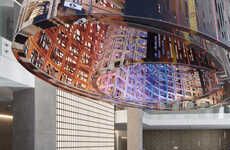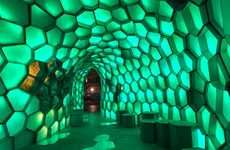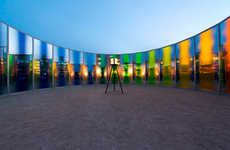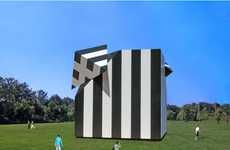
The Firewall Art Installation by Aaron Sherwood is Interactive
Erin Fox — December 29, 2012 — Art & Design
References: aaron-sherwood & wherecoolthingshappen
Creating an interactive world in which your surroundings move and flow with the movement of your body is an interesting concept incorporated into the Firewall Art Installation by Aaron Sherwood in collaboration with Mike Allison. The veiny appeal of the wall simulates the color and visual texture of fire and responds to the touch of any human being.
The Firewall Art Installation is composed of a stretched sheet of spandex, working as a membrane, which is then sensitive to the depth of human touch. The computer generated fire-like visuals move around the touch of a hand, foot or body part and play expressive music with each interaction.
The Firewall Art Installation is composed of a stretched sheet of spandex, working as a membrane, which is then sensitive to the depth of human touch. The computer generated fire-like visuals move around the touch of a hand, foot or body part and play expressive music with each interaction.
Trend Themes
1. Interactive Installations - Creating interactive installations that respond to human touch and movement presents an opportunity for artists and businesses to offer unique and engaging experiences.
2. Simulation Technology - The development and use of simulation technology in art installations and other industries such as education and training can provide innovative solutions and cost-effective methods.
3. Multi-sensory Experiences - The incorporation of visual, auditory, and tactile components in art installations and other experiences can appeal to a wider audience and enhance engagement.
Industry Implications
1. Art - Artists can leverage interactive and simulation technologies to offer unique and immersive art installations that engage viewers in a multi-sensory experience.
2. Entertainment - The use of simulation technology in the entertainment industry can provide new and innovative experiences for audiences, such as interactive exhibits and virtual reality games.
3. Training and Education - Simulation technology can be used in training and education to provide cost-effective and immersive learning experiences.
5.6
Score
Popularity
Activity
Freshness















